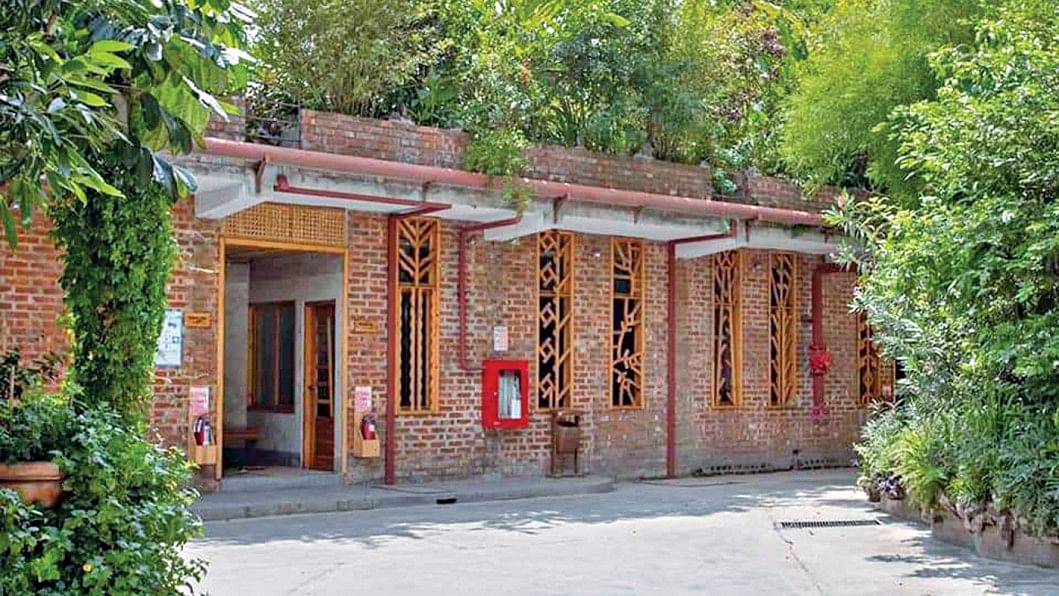Is it a forest? Is it a garden? No, it’s a factory!
From a distance, it appears as a forest. But as one gets closer, it becomes evident that it's in fact a seven-story factory building covered with vines and leaves. After entering the premises, one will see a 30-foot-tall white sculpture of a woman.
There stands the factory of Karupannya Rangpur Limited, flanked by greenery from all sides.
Designed by architect Bayezid Mahbub Khondker and his team from Nakshabid Architects, this eco-marvel is located at Robertsonganj, Rangpur.
Upon entering through the gate of the building, you will be greeted with a symphony of leaves inside. Plants crawl lovingly over the brick-and-mortar structure, taking the shape of a vertical garden.

Four large, 15,000-square-foot reservoirs resembling ponds grace the ground floor, holding 5,00,000 litres of water.
After being used in the dyeing process of Shataranji (a traditional rug), the iron-free water is collected in these reservoirs.
As air flows over the water and the plants cling to the building, it cools significantly. This cool air then rises through four massive 37-foot-diameter hollow pillars effectively acting as natural air conditioners for the entire structure.
The result? A comfortable working environment several degrees cooler than the scorching summer heat, all without a single air conditioner or electric fan.
While the rest of the country grapples with the unbearable heatwave, the nearly 5,000 workers at Karupannya Rangpur Limited toil away in a serene haven. The special architectural technique also results in 80 percent energy saving.
"The design draws inspiration from traditional Bangalee earthen homes in rural areas, which often have an open southern side and a nearby pond. This setup allows cool air to flow over the water and into the building, while warm air rises and exits through roof chimneys," said Bayezid.
The project site covers 14,170 square metres, with a total built-up area of 24,850 square metres. The main factory building occupies 3,820 square metres. Its construction began in 2013, and the factory became operational in early 2017.
Bayezid received two gold medals at the ARCASIA Awards for Architecture-2023, winning in the categories of Socially Responsible Architecture and Industrial Building for the factory.

WASTE MANAGEMENT
But Karupannya Rangpur Limited's commitment to sustainability goes beyond its innovative building design. While any factory produces waste, Karupannya Rangpur is dedicated to minimising its environmental impact through meticulous waste management practices.
The factory cleverly utilises renewable and natural raw materials such as cotton waste from spinning mills, jute fabric, and various plant materials like hogla leaves and banana bark.
This approach not only prevents pollution but also promotes sustainability by repurposing waste materials that would otherwise end up in landfills. The absence of harmful chemical waste and black smoke underscores the factory's dedication to environmental protection.
The company's practices align with the broader goals of reducing carbon footprints and promoting ecological balance.
"By using natural materials and focusing on renewable resources, we ensure that our production processes are environmentally friendly," said Safiqul Salim, the founder of Karupannya Rangpur Limited.
"This approach not only preserves the environment but also showcases the rich cultural heritage of Bangladesh," he said.

THE JOURNEY
The story of Karupannya Rangpur Limited is as inspiring as its architectural marvel.
Safiqul Selim, the founder, was raised at Guptapara in Rangpur city. His journey began back in 1986 when he displayed straw portraits at the Dhaka Shilpa Mela.
Despite initial setbacks, Selim's creativity and perseverance led him to explore the potential of handicrafts of rural Bangladesh, he said.
In 1991, he established Karupanya renting a tiny space in Rangpur, starting with a small Shataranji shop. Over the years, his relentless efforts transformed it into a significant player in the handicraft industry globally, exporting his products to over 50 countries.
"From a small shop to a global exporter, our journey has been fueled by innovation and hard work," reflected Selim.
"Our commitment to environmental sustainability and quality has been the cornerstone of our success," he added.
He also said Karupanya not only prioritises environmental sustainability but also focuses on the welfare of its employees.
Siddharth Lahiri, general manager (Finance and IT), adds, "The workers are the backbone of our operations. We strive to provide them with the best facilities and a secure, pleasant working environment."
This correspondent also spoke to some of the female staffers at the factory. They seemed to share similar sentiments.
Rashidus Sultan Bablu, secretary of the Bangladesh Poribesh Andolon (Bapa) in Rangpur, highlighted the factory's ability to absorb excess heat and maintain environmental purity.
"This is a creative solution that significantly reduces energy consumption. This innovative approach serves as a model for other factories in Bangladesh and beyond, demonstrating that industrial progress does not have to come at the expense of the environment," he said.
"The factory's green design helps maintain the ecological balance and provides a healthier environment for the workers," said Bablu. "It proves that sustainable industrial practices are not only possible but also beneficial for everyone involved."
As climate change continues to pose challenges worldwide and Bangladesh is not out of risk, Karupanya offers a blueprint for balancing industrial activity with ecological responsibility. By integrating traditional wisdom with modern architecture, this factory not only enhances worker comfort but also sets a new standard for sustainable industrial practices, said Rezaul Islam Milon, president of Rangpur Metropolitan Chamber of Commerce and Industry.
He said Karupanya exemplifies how industries can harmonise with nature while achieving economic success and giving comfort to a large number of employees.

 For all latest news, follow The Daily Star's Google News channel.
For all latest news, follow The Daily Star's Google News channel. 


Comments